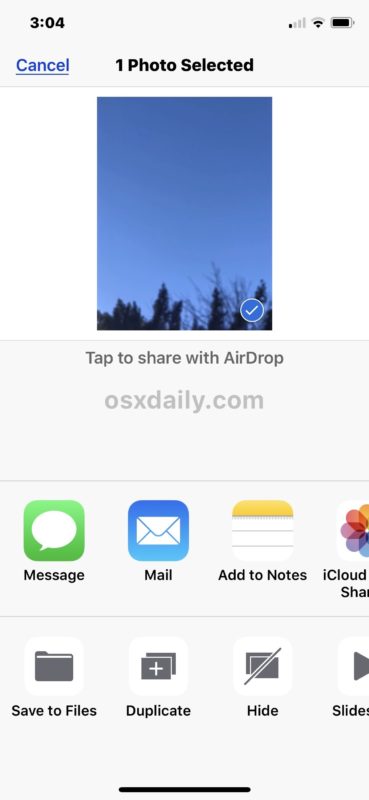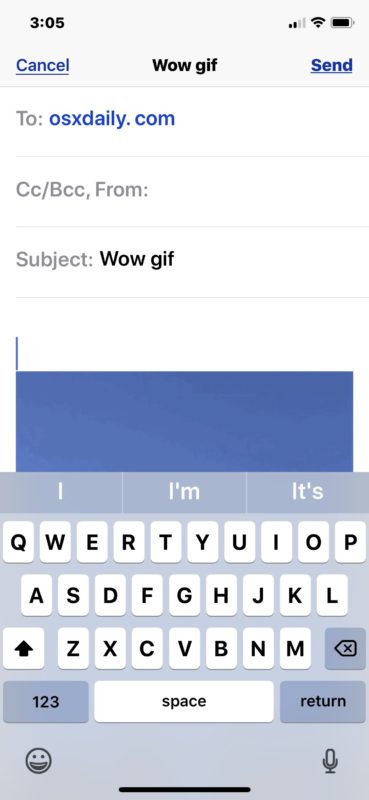How to Send Live Photos as Animated GIF from iPhone or iPad

The iPhone and iPad has a little-known capability to convert looping or bouncing Live Photos to animated GIFs natively by sending them through selected sharing methods.
This approach to share a Live Photo as a GIF is great because it basically requires zero effort at all, and it’s certainly easier and faster than using an app to convert Live Photos to GIF.
Read on to learn how you can easily send and share any Live Photos as an animated gif.
To try this yourself, you will need a Live Photo (or several to choose from). You can always take a few Live Photos with your iPhone or iPad camera first.
How to Share a Live Photo as Animated GIF from iPhone or iPad
Assuming you have a Live Photo ready to go, here’s how you can share and send Live Photos as animated GIFs.
- From the Photos app on iOS, tap and select the Live Photo you want to convert to an animated GIF
- Swipe Up on the Live Photo to access the additional Live Photo Effects options
- Choose “Loop” or “Bounce” from the Effects screen, whichever is most appropriate for your photo or the desired GIF repeating effect
- Now tap the Sharing / Action button as usual (it looks like a box with an arrow flying out of the top)
- Choose “Mail”
- Fill out the email as usual, to whoever you want to send the Live Photo as an animated GIF to, then click “Send” *





The Live Photo will automatically convert to an animated GIF so that the recipient can view the image as an animation regardless of what platform they are on. Just be sure you use Live Photo Effects like Bounce or Loop.
This is great because it allows you to send an animated image to someone on a Windows or Android device, or any other platform that doesn’t support Live Photos (which is anything outside of the modern Apple OS ecosystem).
* You can also email yourself the Live Photo if you want to perform a simple Live Photo to animated GIF conversion.
One thing to note however is that the resulting animated GIF files are quite large, despite being a low resolution, as they appear to prioritize a high frame rate. For example, you can easily end up with a 640 x 480 resolution animated GIF converted from a Live Photo that is 6.5 MB, which is much larger than necessary.
The example animated GIF images below were created by Live Photo conversion using this sharing method, and they are quite large in terms of file size at 4.7mb and 6.4mb.
1:

2:

Perhaps one day iOS will gain a native capability to convert Live Photos into animated GIFs directly from a menu option, but for now that option doesn’t exist. As mentioned above, you can use an app to convert a Live Photo to animated GIF, or you can email yourself the picture and save that which will be an animated GIF. You could also use the Workflow app too, which also lets you convert an Animoji to a GIF as well with a little effort.
Do you know of any other tips or tricks to share Live Photos as animated GIF files? Let us know in the comments!


Such a nice little trick. Thanks for sharing it.
Good tip. The only downside is that the animated portion of the live photos is actually a 3 second long .mov video recorded in HD and with sound. When converting that to GIF, we’re loosing quality and we’re removing the sound from it.
It would be better if Apple allowed access to the actual live photo files, which are actually compressed folders similar to a zip archive that come with a .pvt extension and contain the still image as a jpg and the animaded portion as a .mov file. That way, we could easily extract and share the original .mov file instead of having to convert to GIF and loose a lot of quality and the sound.
Nice that we can share the animated portion of a live photo as a GIF, but it’s actually not the best way to do so and here’s why:
Live photos are actually stored as .pvt file folders that work similar to compressed zip folders and contain inside them the still portion of the live photo as a .jpg picture and the live portion as a 3 second long HD .mov video file -which by the way is recorded with sound-, as well as a metadata.plist file to make the live photo work as intended -which is by tapping and holding on the still photo to play the video-. However, converting the video portion to a simple GIF animation will remove the sound from the video and substantially reduce its image quality.
Therefore, Apple ought to let us users have access to the original .pvt folders so we could easily extract and share the actual .mov video file instead of forcing us to loose quality and the video’s audio by converting it to a cheap GIF animation. Why do they like to make everything so complicated?
Ironically if you use AirDrop to send the Live Photo to some Macs, it transfers as the .mov file rather than an image.
But if you use AirDrop to send the Live Photo to a newest MacOS, it shows as a Live Photo which can be played in Photos app.
Or if you email it, it shows up as a GIF.
There is no consistency which makes sharing a Live Photo a guessing game at best. I am not convinced that “Live Photo” is even a good feature, most people I know that use it are doing so accidentally and are annoyed by the ‘blurry moving pictures’ (as one relative described it recently).
There is consistency indeed. At least there is in iOS, where live photos are always shared as jpg still images unless they’re being sent via imessage or airdrop to other iOS devices.
Even when a live photo attached to an email and sent using the iOS built in mail app, it is always sent as a still jpg. I’m curious, how did you get one attached to an email as a Gif instead of JPG?
Sorry I meant imessage or airdrop to other Apple devices in the first parapgraph.
And the second should’ve read “even when a live photo is attached…”